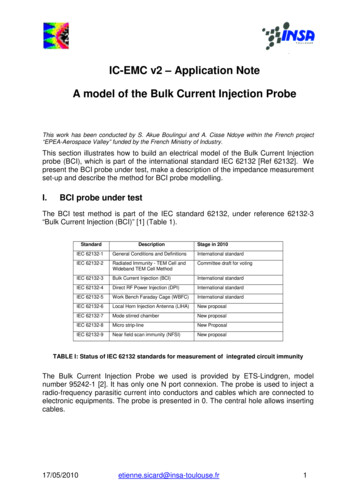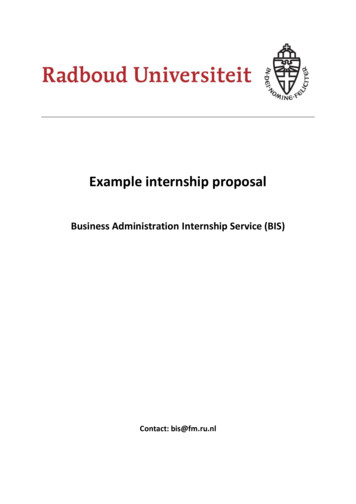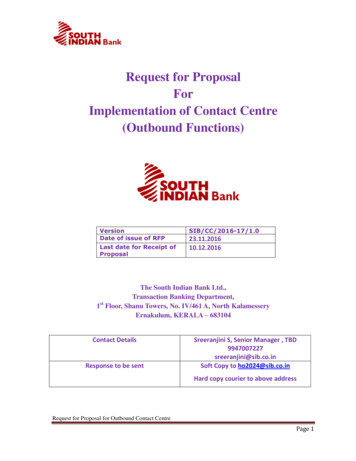
Transcription
Proposal to Perform a High-StatisticsNeutrino Scattering ExperimentUsing a Fine-grained Detectorin the NuMI BeamFebruary 1, 2004AbstractThe NuMI facility at Fermilab will provide an extremely intense beam of neutrinos for the MINOSneutrino-oscillation experiment. The spacious and fully-outfitted MINOS near detector hall will bethe ideal venue for a high-statistics, high-resolution ν and ν–nucleon/nucleus scattering experiment.The experiment described here will measure neutrino cross-sections and probe nuclear effects essential to present and future neutrino-oscillation experiments. Moreover, with the high NuMI beamintensity, the experiment will either initially address or significantly improve our knowledge of awide variety of neutrino physics topics of interest and importance to the elementary-particle andnuclear-physics communities.
The MINERνA CollaborationD. Drakoulakos, P. Stamoulis, G. Tzanakos, M. ZoisUniversity of Athens; Athens, GreeceD. CasperUniversity of California, Irvine; Irvine, California, USAE. PaschosUniversity of Dortmund, Dortmund, GermanyD. Harris, M. Kostin, J.G. Morfı́n , P. ShanahanFermi National Accelerator Laboratory; Batavia, Illinois, USAM.E. Christy, W. Hinton, C.E. Keppel1Hampton University; Hampton, Virginia, USAR. Burnstein, A. Chakravorty2 , O. Kamaev, N. SolomeyIllinois Institute of Technology; Chicago, Illinois, USAS. KulaginInstitute for Nuclear Research, Moscow, RussiaW.K. Brooks, A. Bruell, R. Ent, D. Gaskell, W. Melnitchouk, S.A. WoodThomas Jefferson National Accelerator Facility; Newport News, Virginia, USAI. Niculescu, G. NiculescuJames Madison University, Harrisonburg, Virginia, USAG. Blazey, M.A.C. Cummings, V. RykalinNorthern Illinois University; DeKalb, Illinois, USAS. Boyd, D. Naples, V. PaoloneUniversity of Pittsburgh; Pittsburgh, Pennsylvania, USAA. Bodek, H. Budd, J. Chvojka, P. deBarbaro, S. Manly, K. McFarland , I. Park, W. Sakumoto, R. TengUniversity of Rochester; Rochester, New York, USAR. Gilman, C. Glashausser, X. Jiang, G. Kumbartzki, K. McCormick, R. RansomeRutgers, The State University of New Jersey; Piscataway, New Jersey, USAH. Gallagher, T. Kafka, W.A. Mann, W. OliverTufts University; Boston, Massachusetts, USA1Also at Thomas Jefferson National Accelerator FacilityAlso at Saint Xavier College, Chicago, Illinois, USA Co-spokespersons2
ContentsList of FiguresixList of TablesxiiiI Introduction11Executive Summary32Overview of the MINERνA Experiment2.1 The Fermilab NuMI Facility . . . . . . . . . . . . . . . . . . . . . . . . . . . . . . .2.1.1 The NuMI near experimental hall . . . . . . . . . . . . . . . . . . . . . . . .2.1.2 The NuMI neutrino beam . . . . . . . . . . . . . . . . . . . . . . . . . . . . .2.2 Neutrino Scattering Physics . . . . . . . . . . . . . . . . . . . . . . . . . . . . . . . .2.2.1 Low-energy neutrino cross-sections . . . . . . . . . . . . . . . . . . . . . . .2.2.2 Quasi-elastic scattering . . . . . . . . . . . . . . . . . . . . . . . . . . . . . .2.2.3 Resonances and transition to deep-inelastic scattering . . . . . . . . . . . . . .2.2.4 Coherent pion production . . . . . . . . . . . . . . . . . . . . . . . . . . . .2.2.5 Studying nuclear effects with neutrinos . . . . . . . . . . . . . . . . . . . . .2.2.6 Strangeness and charm production . . . . . . . . . . . . . . . . . . . . . . . .2.2.7 Extracting parton distribution functions . . . . . . . . . . . . . . . . . . . . .2.3 The MINERνA Detector . . . . . . . . . . . . . . . . . . . . . . . . . . . . . . . . .55556778889993Low-Energy Neutrino Scattering Overview3.1 Form Factors and Structure Functions .3.2 Electron versus Neutrino Scattering . .3.3 Sum Rules and Constraints . . . . . . .3.4 Final States . . . . . . . . . . . . . . .45.1313131314Existing Neutrino Scattering Data4.1 Quasi-elastic Scattering . . . . . . . . . . .4.2 Other Exclusive Charged-current Channels .4.3 Neutral-current Measurements . . . . . . .4.4 Hadronic Final States . . . . . . . . . . . .4.5 Strange and Charmed Particle Production .4.6 Total Cross-sections . . . . . . . . . . . . .4.7 Structure Functions . . . . . . . . . . . . .4.8 Summary . . . . . . . . . . . . . . . . . .171717171818181818The NuMI Beam and MINERνA Event Sample5.1 Energy Options . . . . . . . . . . . . . . . .5.2 MINERνA Event Rates . . . . . . . . . . . .5.3 Baseline MINOS Run Plan . . . . . . . . . .5.4 MINERνA Data Samples . . . . . . . . . . .2323252525.v
5.5Accuracy of Predicted Neutrino Flux . . . . . . . . . . . . . . . . . . . . . . . . . . .26II Physics Motivation and 588Coherent Neutrino-Nucleus Scattering8.1 Theory . . . . . . . . . . . . . . . . . . . . . . . . . . . . . . . . . . . . . . . . . . .8.2 Experimental Signatures . . . . . . . . . . . . . . . . . . . . . . . . . . . . . . . . .8.3 Expected Results . . . . . . . . . . . . . . . . . . . . . . . . . . . . . . . . . . . . .636364649Strangeness and Charm Production9.1 Overview . . . . . . . . . . . . . . . . . . . . . . . . . . . . . . . . . . . . . . . . .9.2 Neutrino Strangeness Production Near Threshold . . . . . . . . . . . . . . . . . . . .9.3 Strangeness Production Measurements at Bubble Chambers . . . . . . . . . . . . . . .9.4 MINERνA Samples Amenable to Hypothesis Fitting . . . . . . . . . . . . . . . . . .9.5 Expected Results . . . . . . . . . . . . . . . . . . . . . . . . . . . . . . . . . . . . .9.5.1 Backgrounds to nucleon decay . . . . . . . . . . . . . . . . . . . . . . . . . .9.5.2 Measurement of σ(νΛK ) . . . . . . . . . . . . . . . . . . . . . . . . . . . .9.5.3 Strangeness-changing neutral currents . . . . . . . . . . . . . . . . . . . . . .9.5.4 Hyperon beta-decay and inverse neutrino processes . . . . . . . . . . . . . . .9.5.5 Charm production physics . . . . . . . . . . . . . . . . . . . . . . . . . . . .71717172737475777880817Quasi-Elastic Scattering6.1 Quasi-elastic Cross-sections . . . . . . . . . . . . . . . . .6.2 Form-factors in Quasi-elastic Scattering . . . . . . . . . . .6.2.1 Vector form-factor discrepancy at high Q2 . . . . . .6.2.2 Form-factor deviations from dipole behavior . . . .6.3 Axial Form-factor of the Nucleon . . . . . . . . . . . . . .6.3.1 Vector form-factors and MA . . . . . . . . . . . . .6.3.2 Measurement of the axial form-factor in MINERνA6.4 Nuclear Effects in Quasi-elastic Scattering . . . . . . . . . .6.4.1 Fermi gas model . . . . . . . . . . . . . . . . . . .6.4.2 Bound nucleon form-factors . . . . . . . . . . . . .6.4.3 Intra-nuclear rescattering . . . . . . . . . . . . . . .Resonance-Mediated Processes7.1 Overview of Resonant Electroproduction . . . . . . . .7.2 Weak Resonance Excitation . . . . . . . . . . . . . . .7.3 Nuclear Effects . . . . . . . . . . . . . . . . . . . . .7.4 Exclusive Channels . . . . . . . . . . . . . . . . . . .7.5 Expected Results . . . . . . . . . . . . . . . . . . . .7.5.1 Complementary studies at JLab . . . . . . . .7.5.2 Resonant form-factors and structure functions .7.5.3 Single-pion final states . . . . . . . . . . . . .vi.
10 Perturbative/Non-Perturbative Interface10.1 Parton Distribution Functions . . . . .10.2 Quark Distributions at Large x . . . .10.3 Quark/Hadron Duality . . . . . . . .10.4 QCD Moments . . . . . . . . . . . .10.5 Expected Results . . . . . . . . . . .83838487899011 Generalized Parton Distributions11.1 The Nucleon Spin Puzzle and GPDs . . . . . . . . . . . . . . . . . . . . . . . . . . .11.2 Deeply-virtual Compton Scattering . . . . . . . . . . . . . . . . . . . . . . . . . . . .11.3 Measurement of GPDs in MINERνA . . . . . . . . . . . . . . . . . . . . . . . . . . .95959597.12 Studying Nuclear Effects with Neutrinos12.1 Final-state Interactions . . . . . . . . . . . . . . . .12.2 Nuclear Effects and Interaction Probabilities . . . . .12.2.1 Low-x: Nuclear shadowing . . . . . . . . . .12.2.2 Mid-x: Anti-shadowing and the EMC effect .12.2.3 High-x: Multi-quark cluster effects . . . . .12.3 Measuring Nuclear Effects in MINERνA . . . . . .12.3.1 Multiplicities and visible hadron energy . . .12.3.2 xBj -dependent nuclear effects . . . . . . . .12.4 Nuclear Effects and Determination of sin2 θW . . . .999910110110210310310410410513 MINERνA and Oscillation Measurements13.1 Neutrino Oscillation Landscape . . . . . . . . . .13.2 Benefits of MINERνA to Oscillation Experiments .13.3 m223 Measurements . . . . . . . . . . . . . . . .13.4 Neutrino Energy Calibration . . . . . . . . . . . .13.4.1 Charged and neutral pion production . . . .13.4.2 Charged particle multiplicities . . . . . . .13.4.3 Intra-nuclear scattering . . . . . . . . . . .13.4.4 Expected results . . . . . . . . . . . . . .13.5 θ13 Measurements . . . . . . . . . . . . . . . . . .13.6 νe Appearance Backgrounds . . . . . . . . . . . .13.6.1 Beam νe . . . . . . . . . . . . . . . . . . .13.6.2 Neutral-current π0 production . . . . . . .109109111111112112112112113114116116117.III Project Description12314 The NuMI Near Experimental Hall14.1 Utilities . . . . . . . . . . . . . . .14.2 Detector Placement . . . . . . . . .14.3 Impact on MINOS . . . . . . . . .14.4 MARS Simulation of Radiation Flux14.5 Fluxes in MINERνA . . . . . . . .125125125126126130.vii.
15 Monte Carlo Studies and Performance15.1 Event Generators . . . . . . . . . . . . . . . .15.2 Beam Simulation . . . . . . . . . . . . . . . .15.3 Detector Simulation . . . . . . . . . . . . . . .15.3.1 Interface to the GNuMI flux . . . . . .15.3.2 Interface to the event generators . . . .15.3.3 Geometry . . . . . . . . . . . . . . . .15.3.4 Hits and digitizations . . . . . . . . . .15.4 Photon Transport Simulations . . . . . . . . .15.5 Event Reconstruction . . . . . . . . . . . . . .15.5.1 Pattern recognition . . . . . . . . . . .15.5.2 Coordinate reconstruction . . . . . . .15.5.3 Track reconstruction . . . . . . . . . .15.5.4 Vertex reconstruction . . . . . . . . . .15.5.5 Particle identification . . . . . . . . . .15.5.6 Energy reconstruction and containment15.6 Event Categorisation . . . . . . . . . . . . . 4316 Detector Design16.1 Overview of MINERνA Detector Design . . . . . .16.2 Muon Toroid Performance . . . . . . . . . . . . . .16.3 Photosensors for MINERνA . . . . . . . . . . . . .16.4 Scintillator Strips . . . . . . . . . . . . . . . . . . .16.5 Electronics . . . . . . . . . . . . . . . . . . . . . .16.5.1 Front-end boards . . . . . . . . . . . . . . .16.5.2 PMT boxes, readout electronics and controls16.5.3 Whither the TRiP chip? . . . . . . . . . . .16.6 Parameters of the MINERνA Detector . . . . . . . .145146155155157159159162163163.17 Cost and Schedule16717.1 Description and Summary of Costs . . . . . . . . . . . . . . . . . . . . . . . . . . . . 16717.2 Schedule . . . . . . . . . . . . . . . . . . . . . . . . . . . . . . . . . . . . . . . . . . 169IV Appendices173A Cryogenic LH2 and LD2 Targets175B Off-Axis Running177viii
List of 2728293031323334Sub-detectors of the MINERνA detector . . . . . . . . . . . . . . . . . . . . . . . . .Total neutrino and anti-neutrino cross-sections . . . . . . . . . . . . . . . . . . . . . .Existing charged-current νµ cross-section data . . . . . . . . . . . . . . . . . . . . . .Cross-sections for charged-current single-pion production . . . . . . . . . . . . . . . .Layout of NuMI beamline components and near detector hall. . . . . . . . . . . . . .Charged-current interaction spectra for the LE, sME and sHE beams . . . . . . . . . .Charged-current interaction spectra for the ME and HE beams . . . . . . . . . . . . .Expected xBj and Q2 distributions in MINERνA . . . . . . . . . . . . . . . . . . . .Quasi-elastic neutrino cross-section data . . . . . . . . . . . . . . . . . . . . . . . . .Quasi-elastic anti-neutrino cross section data . . . . . . . . . . . . . . . . . . . . . . .Cross section for MINERνA assuming a 3 ton fiducial volume, 4 year run, perfectresolution, 100% detection efficiency, BBA-2003 form factors with MA 1.00 GeV,and the Fermi gas model. . . . . . . . . . . . . . . . . . . . . . . . . . . . . . . . . .Ratio of GpE to GpM showing discrepancy between two techniques . . . . . . . . . . .Deviation of GpM from dipole form . . . . . . . . . . . . . . . . . . . . . . . . . . . .Comparison between BBA-2003 cross-sections and dipole with GnE 0 . . . . . . . .Contributions to the Q2 distribution of quasi-elastic scattering in MINERνA. . . . . .Comparison of Q2 distributions for neutrinos with two sets of form-factors . . . . . . .Extraction of FA in MINERνA . . . . . . . . . . . . . . . . . . . . . . . . . . . . . .MINERνA sensitivity to FA /FA (Dipole) . . . . . . . . . . . . . . . . . . . . . . . .MINERνA sensitivity to FA /FA (Dipole) . . . . . . . . . . . . . . . . . . . . . . . .Simulated charged-current quasi-elastic interaction . . . . . . . . . . . . . . . . . . .Suppression of bound cross-sections in Fermi gas model . . . . . . . . . . . . . . . .Fermi gas model parameters extracted from electron-scattering data . . . . . . . . . .Ratio of bound to free nucleon form-factors F1 , F2 , and FA . . . . . . . . . . . . . . .Inclusive electron scattering showing the and other resonances . . . . . . . . . . . .Invariant-mass spectra from p(e, e X) . . . . . . . . . . . . . . . . . . . . . . . . . .Total pion production cross-sections. . . . . . . . . . . . . . . . . . . . . . . . . . . .π energy distribution for νµ –O scattering . . . . . . . . . . . . . . . . . . . . . . . .W and Q2 reconstruction for single-π events . . . . . . . . . . . . . . . . . . . . . . production . . . . . . . . . . . . . . . . . . . . . . . . . . . . . . . . . . . . . .Single charged pion resolution derived from MINERνA Monte Carlo. . . . . . . . . .Differential cross-section dσ/dQ2 for single-pion production . . . . . . . . . . . . . .Charged-current coherent scattering cross-sections . . . . . . . . . . . . . . . . . . .Charged-current coherent scattering in MINERνA . . . . . . . . . . . . . . . . . . . .Topological and kinematic quantities used to define the coherent sample. In all plots thesolid histogram is the coherent sample and the dashed histogram are background processes. The relative normalizations of the two distributions in the initial plot is arbitrary,subsequent plots show the effect of the applied cuts. Top Left: Visible charged tracks.Top Right: Distance between the event vertex and the location of the pion interaction(in cm). Bottom Left: Bjorken-x as computed from the true pion and muon 4-momenta.Bottom Right: Square of the 4-momentum transfer to the nucleus (in GeV2 ) as calculated from the pion and muon 4-momenta. . . . . . . . . . . . . . . . . . . . . . . . 955565759606162636568
60616263646566676869707172737475767778Coherent cross-sections as measured by MINERνA compared with existing publishedresults. MINERνA errors here are statistical only. . . . . . . . . . . . . . . . . . . .Coherent cross-sections as a function of atomic number. . . . . . . . . . . . . . . . . .Associated production in the ANL bubble chamber . . . . . . . . . . . . . . . . . . .Time profile of associated-production event in a water Cherenkov detector . . . . . . .Ratio of data to predictions based on CTEQ6 NLO pdf’s vs x1 . . . . . . . . . . . . .Comparison of SLAC electron scattering results with CTEQ NLO prediction . . . . .Nucleon transverse and longitudinal structure functions from e–p data . . . . . . . . .DIS kinematics and containment in MINERνA . . . . . . . . . . . . . . . . . . . . .Structure function F2 data in the resonance region on various nuclei . . . . . . . . . .Ratio of electron-nucleus scattering data to electron-deuterium . . . . . . . . . . . . .Forward virtual Compton and “Handbag” diagrams . . . . . . . . . . . . . . . . . . .The DVCS process and interfering diagrams . . . . . . . . . . . . . . . . . . . . . . .Reactions sensitive to GPDs in neutrino scattering. . . . . . . . . . . . . . . . . . . .F2 (Nuclear)/F2 (D2 ) vs. xBj . . . . . . . . . . . . . . . . . . . . . . . . . . . . . . .Shadowing effects in Iron at Q2 0.7(GeV/c)2 . . . . . . . . . . . . . . . . . . . . .Average multiplicity vs. hadronic energy . . . . . . . . . . . . . . . . . . . . . . . . .Fraction of fully-contained nuclear target events vs. W . . . . . . . . . . . . . . . . .Ratio of shadowing effects off Pb, Fe and C targets . . . . . . . . . . . . . . . . . . .π momenta for 3 GeV charged-current interactions on Carbon, Iron and Lead . . . .Nuclear rescattering effects on reconstructed neutrino energy . . . . . . . . . . . . . .Nuclear rescattering effects on charged-particle multiplicity and event spectra . . . . .Nuclear rescattering effects on a MINOS-like m2 measurement . . . . . . . . . . . .MINOS 3σ sensitivity to θ13 vs. systematic background uncertainty . . . . . . . . . .Topological electron/π0 separation in MINERνA . . . . . . . . . . . . . . . . . . . .νe flux measurement in MINERνA . . . . . . . . . . . . . . . . . . . . . . . . . . . .Simulated neutral-current π0 -production event . . . . . . . . . . . . . . . . . . . . . .Selection of neutral-current single-π0 production . . . . . . . . . . . . . . . . . . . .Angular distribution of neutral-current single-π0 production sample . . . . . . . . . .Isometric view of MINERνA . . . . . . . . . . . . . . . . . . . . . . . . . . . . . . .Plan view of MINERνA . . . . . . . . . . . . . . . . . . . . . . . . . . . . . . . . .Front view of MINERνA . . . . . . . . . . . . . . . . . . . . . . . . . . . . . . . . .νµ energy spectrum within 5 m of NuMI axis . . . . . . . . . . . . . . . . . . . . . .νµ energy spectrum within 1 m of NuMI axis . . . . . . . . . . . . . . . . . . . . . .νµ radial distribution at near detector hall . . . . . . . . . . . . . . . . . . . . . . . .Neutrino beam components. . . . . . . . . . . . . . . . . . . . . . . . . . . . . . . .Light collection efficiency vs. position across strip . . . . . . . . . . . . . . . . . . .Light yield for different strip and fiber dimensions . . . . . . . . . . . . . . . . . . . .Tracking performance for muons from quasi-elastic interactions . . . . . . . . . . . .Vertex resolution for charged-current quasi-elastic interactions . . . . . . . . . . . . .dE/dx vs. range from stopping point for π , K and protons . . . . . . . . . . . . .Particle identification performance for stopping tracks, using dE/dx. . . . . . . . . . .Fraction of hadronic energy escaping detector . . . . . . . . . . . . . . . . . . . . . .Probability of visible hadronic energy leakage. . . . . . . . . . . . . . . . . . . . . .Sub-detectors of the MINERνA detector . . . . . . . . . . . . . . . . . . . . . . . . 138139141142143144145
7980818283848586878889909192939495Side view of MINERνA detector . . . . . . . . . . . . . . . . . . . . . . . . . . . . .Assembly of scintillator strips into planes. . . . . . . . . . . . . . . . . . . . . . . . .Planes and absorbers in inner and outer detectors . . . . . . . . . . . . . . . . . . . .Planes and modules in cross-section in the active target region . . . . . . . . . . . . .Outline of MINERνA detector . . . . . . . . . . . . . . . . . . . . . . . . . . . . . .Muon range/toroid and upstream veto plane design . . . . . . . . . . . . . . . . . . .The Hadronic Calorimeter plane design . . . . . . . . . . . . . . . . . . . . . . . . .Electromagnetic calorimeter plane design . . . . . . . . . . . . . . . . . . . . . . . .Active target plane design . . . . . . . . . . . . . . . . . . . . . . . . . . . . . . . . .Light yield vs. distance along strip . . . . . . . . . . . . . . . . . . . . . . . . . . . .A simplified schematic of the front end electronics of the TRiP chip . . . . . . . . . .MINERνA strip occupancy . . . . . . . . . . . . . . . . . . . . . . . . . . . . . . . .Response of the TRiP chip to 5 fC injected with a 10 µs gate. . . . . . . . . . . . . . .Timing resolution of the TRiP chip . . . . . . . . . . . . . . . . . . . . . . . . . . . .Off-axis energy distributions . . . . . . . . . . . . . . . . . . . . . . . . . . . . . . .Possible sites for off-axis running . . . . . . . . . . . . . . . . . . . . . . . . . . . .Off-axis drift cross-section . . . . . . . . . . . . . . . . . . . . . . . . . . . . . . . 8178
xii
List of Tables123456789101112131415161718Neutral-current measurements . . . . . . . . . . . . . . . . . . . . . . . . . . . . . . 19MINERνA event rates for different beam configurations. . . . . . . . . . . . . . . . . 25Hypothetical four-year proton luminosity scenario . . . . . . . . . . . . . . . . . . . . 25Total event rates for different reaction channels in four-year run . . . . . . . . . . . . . 27Kinematic distribution of quasi-elastic sample. . . . . . . . . . . . . . . . . . . . . . . 28Kinematic distribution of resonant sample. . . . . . . . . . . . . . . . . . . . . . . . . 28Kinematic distribution of deep-inelastic sample. . . . . . . . . . . . . . . . . . . . . . 29Existing data on coherent pion production . . . . . . . . . . . . . . . . . . . . . . . . 66Coherent cuts . . . . . . . . . . . . . . . . . . . . . . . . . . . . . . . . . . . . . . . 66Event populations for kinematically constrainable samples of exclusive-channel strangenessproduction reactions, obtainable in a four-year exposure of the three-ton inner fiducialvolume of MINERνA. . . . . . . . . . . . . . . . . . . . . . . . . . . . . . . . . . . 75Statistical errors on Fe/C ratio vs. xBj bin . . . . . . . . . . . . . . . . . . . . . . . . 107MARS model interactions for ν and ν . . . . . . . . . . . . . . . . . . . . . . . . . 131Particle fluxes averaged over the active target.Eth is a threshold kinetic energy used inthe simulations. . . . . . . . . . . . . . . . . . . . . . . . . . . . . . . . . . . . . . . 132Electronics design requirements and parameters for MINERνA . . . . . . . . . . . . . 159Parts count for MINERνA Electronics Design . . . . . . . . . . . . . . . . . . . . . . 163Channel count by sub-detector . . . . . . . . . . . . . . . . . . . . . . . . . . . . . . 164Mass by sub-detector . . . . . . . . . . . . . . . . . . . . . . . . . . . . . . . . . . . 164Summary of MINERνA Detector Costs . . . . . . . . . . . . . . . . . . . . . . . . . 171xiii
xiv
Part IIntroduction1
2
1 Executive SummaryThe imminent completion of the NuMI beamline, which will be the highest intensity neutrino beamlinein the world for many years after its completion, offers the particle and nuclear physics community anew opportunity. By constructing a fully active neutrino detector to run for the first time in a high rateneutrino beam, the MINERνA experiment, a collaboration between the high energy physics communityalready working at Fermilab and groups of new users from the medium energy nuclear physics community, proposes to exploit this opportunity to access a broad and rich program in neutrino scatteringphysics.MINERνA will be able to complete a physics program of high rate studies of exclusive final statesin neutrino scattering, as described in Chapters 6–8, of elucidation of the connection between pQCDand QCD in non-perturbative regime, as described in Chapter 10, and of studies of the axial current inthe elastic (Chapter 6), DIS (Chapter 10) and off-forward (Chapter 11) regimes, as well as inside thenucleus (Chapter 12). MINERνA then seeks the application of its data to aid present and future neutrinooscillation experiments (Chapter 13), where understanding the details of neutrino cross-sections andfinal states is essential for separating backgrounds to oscillation from signal.MINERνA can address all these topics, and can bring a new physics focus to the Fermilab programwith a simple, low-risk detector of modest cost, as detailed in Chapters 14 and 16–17. The performanceof this detector is expected to be excellent for resolving individual final states as well as measuringkinematics in inclusive reactions as documented in Chapter 15.As we submit this proposal to Fermilab, we are also preparing to request funding from sourcesoutside Fermilab to pursue this interdisciplinary experiment at the intersection of particle and nuclearphysics. We request that the lab and its Physics Advisory Committee support this physics and our effortsto seek outside funding by granting stage one approval to MINERνA in time for this approval to enterinto funding deliberations this spring and summer.3
4
2 Overview of the MINERνA ExperimentUpcoming neutrino oscillation experiments in the United States, Europe and Japan are driving the construction of new, very intense neutrino beamlines required to achieve reasonable event rates at detectorslocated hundreds of kilometers away. These new beamlines will allow us to initiate a vigorous researchprogram at a detector, located close to the production target, where event rates are much higher thanat the previous generation of neutrino beam facilities. In addition, it is neutrino oscillation experiments, with their low-energy neutrinos and massive nuclear targets, which highlight the need for muchimproved knowledge of low-energy neutrino–Nucleus interactions, the overall goal of this experiment.At Fermilab, the new neutrino facility NuMI, designed for the MINOS neutrino oscillation experiment, will be based on the Main Injector (MI) accelerator. The neutrino beams from the MI yieldseveral orders of magnitude more events per kg of detector per year of exposure than the higher-energyTevatron neutrino beam. This highlights the major improvement of this next generation of neutrinoexperiments. One can now perform statistically-significant experiments with much lighter targets thanthe massive iron, marble and other high-A detector materials used in the past. That these facilities aredesigned to study neutrino oscillations points out the second advantage of these neutrino experiments:An excellent knowledge of the neutrino beam will be required to reduce the beam-associated systematic uncertainties of the oscillation result. This knowledge of the neutrino spectrum will also reduce thebeam systematics in the measurement of neutrino-scattering phenomena.To take advantage of these major improvements in experimental neutrino physics possible with theNuMI beam and facility, a collaboration of elementary particle and nuclear physics groups and institutions named “MINERνA” (Main INjector ExpeRiment: ν–A) has been formed. This collaborationrepresents the combined efforts of two earlier groups that submitted Expressions of Interest (EOI) [1]to the Fermilab PAC in December, 2002. The goal of the MINERνA experiment is to perform a highstatistics neutrino-nucleus scattering experiment using a fine-grained detector located on-axis, upstreamof the MINOS near detector.2.1 The Fermilab NuMI FacilityThe Fermilab NuMI on-site facility is made up of the beamline components, the underground facilitiesto contain these components and a large, on-site experimental detector hall to contain the MINOS neardetector, located just over 1 km downstream of the target and 100 meters underground.2.1.1The NuMI near experimental hallThis experimental hall is being constructed and completely outfitted for the MINOS near detector. Thehall is 45 m long, 9.5 m wide and 9.6 m high. There is a space upstream of the MINOS near detector amounting to, roughly, a cylindrical volume 26 m long and 3 m in radius for additional detector(s)which, were it desired, could use the MINOS near detector as an external muon-identifier and spectrometer.2.1.2The NuMI neutrino beamThe neutrino energy distribution of the NuMI beam can be chosen by changing the distance of the targetand second horn from the first horn, as in a zoom lens. The energy of the beamline can also be varied,essentially continuously, by simply changing the target’s distance from the first horn and leaving the5
second horn in a fixed position. There is a
Neutrino Scattering Experiment Using a Fine-grained Detector in the NuMI Beam February 1, 2004 Abstract The NuMI facility at Fermilab will provide an extremely intense beam of neutrinos for the MINOS neutrino-oscillation experiment. The spa











